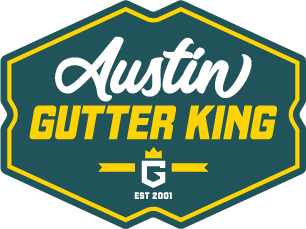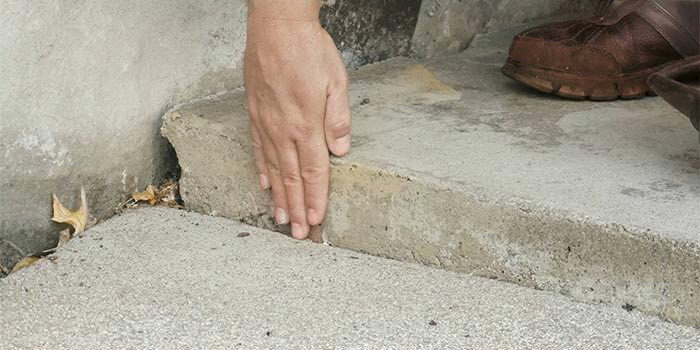Austin Concrete Slab Leveling, Raising & Repairs
Contents
If you’re looking to repair your concrete slabs, slabjacking or concrete leveling is a great alternative to replacement. Whether it’s an uneven driveway, garage floor, patio, sidewalk, or walkway, our team will assess the situation and provide a comprehensive service to get you back on track. So whether you’re dealing with minor cosmetic issues or in need of structural repairs, you can rest assured that we have the expertise and know-how to get the job done right. Contact us today for reliable slabjacking services in Austin and the surrounding areas.
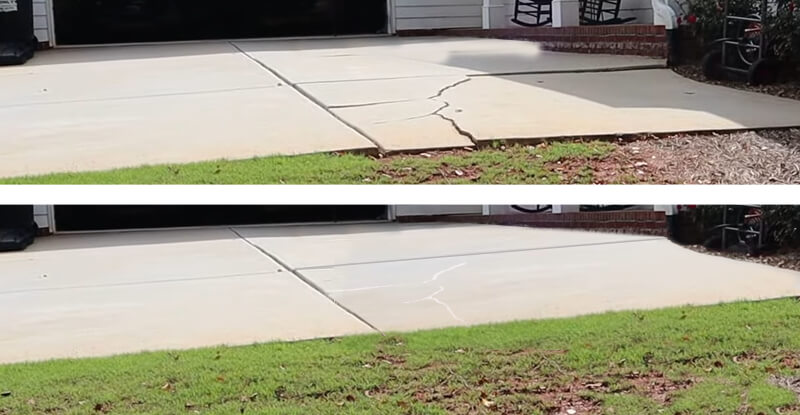
The process of slab jacking can be confusing. That’s why we want to make sure you have all the information you need to decide if it’s the right repair solution for you.
What is Concrete Lifting?
Concrete Lifting is a process of returning concrete to its original position. It’s an effective method that involves drilling small holes into the slab and injecting a filler material beneath it. This material then expands, raising the concrete back up to where it should be. It’s important to note that there are two distinct methods of Concrete Lifting: mudjacking and slabjacking. Both are effective in getting the job done by providing a level surface.
Whatever your reason for leveling concrete slabs, whether it’s to prevent further cracking or simply to give your home a new look, Concrete Lifting can provide the results you’re looking for. Its reliable, cost-effective nature makes it an attractive repair option for many homeowners.
Slabjacking
Slabjacking is a newer technique used to lift and support sinking or settling concrete by raising concrete with foam. Unlike other techniques like concrete lifting, leveling, or mudjacking, it uses an injection of a specialized grout below the slab to lift and support it. This method has been proven to be effective at stabilizing concrete and is often less costly and faster than having to replace your slab entirely.
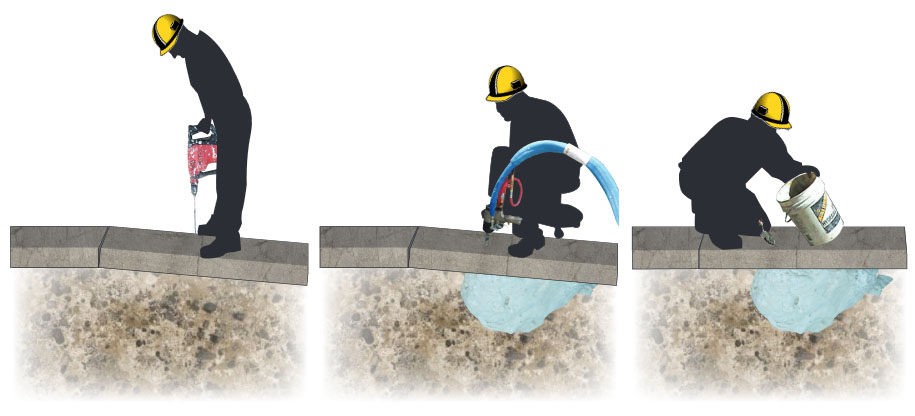
Ultimately, whatever repair project you’re facing – whether it be slabjacking or another method – it’s important to do your research and find the option that makes the most sense for your situation. We hope this article can help you make an informed decision, so you can get your project started on the right foot!
How Slabjacking Works
- Step 1: Look for the concrete slab or area that is not at the proper level or height and needs to be filled to get the proper concrete level.
- Step 2: When the problem is exactly located, then we will start to make a small drilling hole into the concrete slab. Since we usually use a small drill bit, the hole should be between 2″-3″.
- Step 3: After the holes have been drilled in the concrete, then spray foam will be injected through the drilled holes.
What is Concrete Leveling?
Concrete leveling is a misnomer when it comes to outside slabs. What you actually want is the sinking side of the slab to be lifted so that it’s even with the other side and, more importantly, just enough of a slope to enable water drainage away from your home’s foundation.
Rather than ‘leveling’ an outside slab, a contractor will lift and adjust the concrete to achieve this gradient. This ensures that any rainwater won’t seep into the ground near your house or cause further damage. In essence, this process is about raising one side of the slab to keep it equal in height with the rest, but also angled away from your property.
This can be a tricky job and typically requires the help of an experienced professional. They understand how to effectively evaluate your patio or driveway and properly apply the necessary adjustments. A quality service provider can help you maintain a concrete surface that looks great, is safe and secure, and provides effective drainage while preventing future damage.
Mudjacking vs. Slabjacking
When it comes to raising sunken concrete, many people wonder which option is the best: mudjacking or slabjacking. Although both methods involve pumping material into the ground beneath sunken concrete, there are some key differences between them.
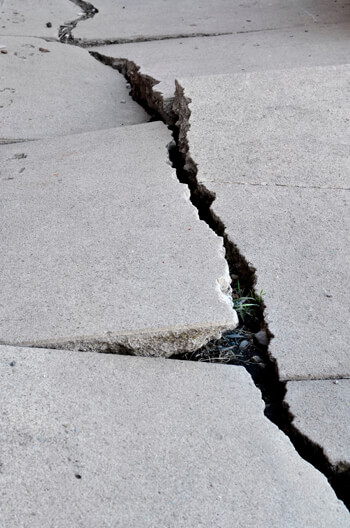
Slabjacking uses a foam injection system to fill the space beneath sunken concrete. This method is much lighter than mudjacking and can be used to lift larger sections of concrete. Since the foam is a lightweight material, there’s less pressure placed on the surrounding foundation, making this a more permanent solution. In addition, since the foam is injected directly into the soil beneath the slab, there’s less disruption to the surface of the concrete.
Let’s look at each a little more in-depth…
What is Mudjacking?
Mudjacking is an innovative and cost-effective way to raise sunken concrete slabs. Professional contractor drills through the slab and injects a unique mixture, often referred to as “mud” or a concrete slurry, to lift the slab back into place. This proprietary blend includes concrete, sand, limestone, water, and other materials that vary depending on the type of equipment used and the contracting company chosen. The mixture must be thin enough to move easily through a hose and injection gun but thick enough to eventually dry out or cure. The pressure from the injection of this material is what lifts the slab – an inexpensive solution compared to more costly alternatives. Mudjacking is a reliable and proven method for restoring concrete surfaces, giving peace of mind to any property owner.
How is Slabjacking Different?
Slabjacking is an effective solution for lifting concrete slabs without the mess of a traditional concrete or limestone slurry, which often requires multiple applications. With slabjacking, we inject a two-part polyurethane foam instead – this method is both easier to control and more durable than mudjacking.
In the long run, slabjacking with polyurethane foam will cost you more upfront, but it also promises lasting results as the foam won’t decompose over time like mudjacking. In other words, when you choose slabjacking with polyurethane foam, you can rest assured knowing that your concrete slab will stay in place indefinitely until the ground below it erodes.
Verdict
Concrete lifting is a process that has its limits and should only be used for certain applications. It is important to remember that the slab must wholly consist of concrete – other materials such as brick pavers, tiles, asphalt, or any other substance will not work with this technique. Additionally, due to weather constraints, slabjacking cannot be done when the ground is frozen and mudjacking cannot be done once temperatures drop below freezing since water is necessary in the mixture. Taking these considerations into account can help ensure that concrete lifting is executed safely and effectively.
Ultimately, when it comes to choosing between mudjacking and slabjacking, it’s important to consider the size of your project and budget as well as the desired result. While mudjacking may be quicker and cheaper, slabjacking offers a more permanent solution with less disruptive installation. For these reasons, slabjacking is often the preferred option for raising sunken concrete.
What Does Slabjacking Cost?
What will slabjacking cost me? Good question! We set our job minimum at $2000 to ensure you get the quality service and materials you deserve. But don’t worry – that doesn’t just apply to a single spot on your property. We define the job site as your entire property, so if you have multiple areas that need repair, they’ll all count toward one job. Does that mean a patio in your backyard, plus two steps leading to your porch? Not a problem. It’s still going to be around $2000.
Generally, slabjacking is roughly $10 per square foot – though keep an eye out for additional costs. If there’s significant erosion or settling underneath your concrete slabs, it takes more fill material than usual to finish the job. In this case, you should discuss with your contractor beforehand about possible budget limitations and whether lifting is the best option for you.
Just to be extra sure, take a look at your gutter downspouts, sump pump lines, and any broken pipes or drains. These can usually be the source of the issue, and making repairs to plumbing, extending downspouts, or rerouting drainage lines will help make sure your repair is permanent.
Investing in slabjacking could save you time, money, and effort in the long run – and Austin Gutter King can help make sure you’re taken care of from start to finish. Call Us Today at (512) 270-2445 For A Free Quote.
